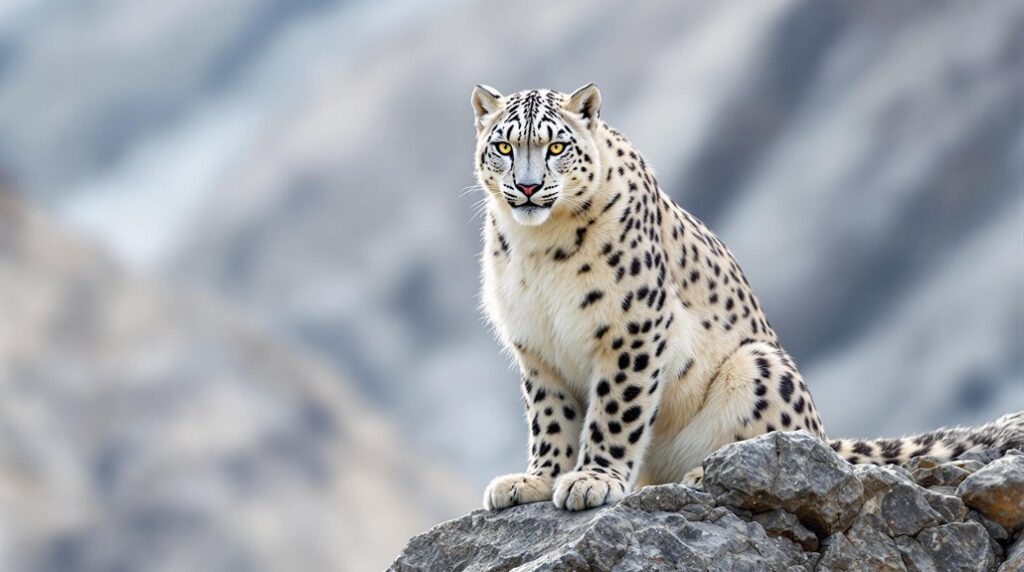This blog contains affiliate links. As part of afiiliate networks and as an Amazon Associate, I earn from qualifying purchases. If you make a purchase through these links, I may earn a small commission at no additional cost to you. I only recommend products and services that I believe in and have personally used or researched. Your support helps me continue to provide quality content—thank you!
Telephoto lenses are essential for wildlife photography, as your field experiences are only as good as the gear you’re using. A quality telephoto lens makes all the difference when capturing that perfect shot of a distant eagle or elusive deer. Before investing, consider factors like focal length, weight, stabilization, and weather sealing. The right telephoto lens can elevate your wildlife portfolio—but which one deserves a spot in your camera bag?
Canon EF 75-300mm f/4-5.6 III Telephoto Zoom Lens for Canon SLR Cameras
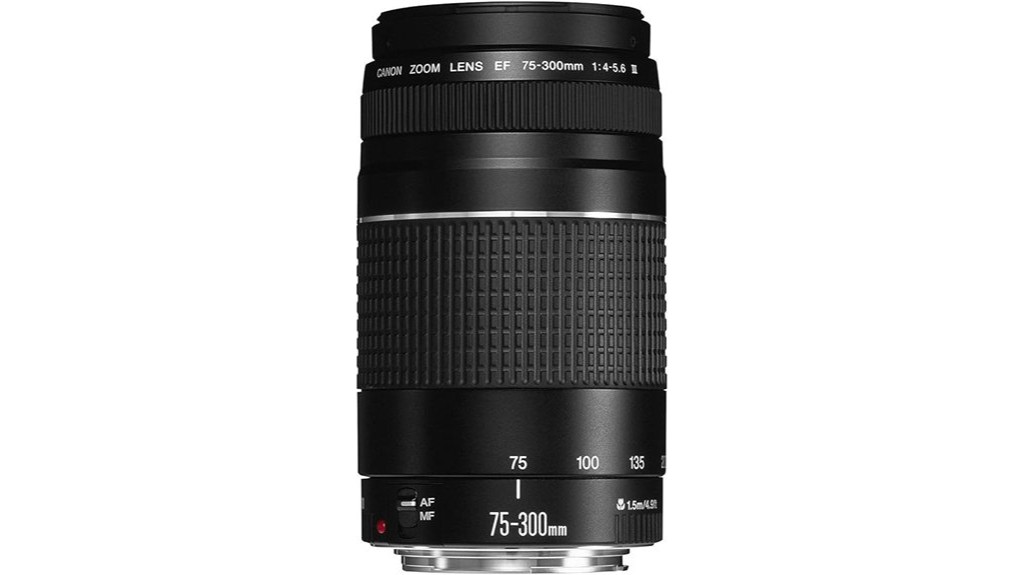
Wildlife enthusiasts on a budget will find the Canon EF 75-300mm telephoto zoom lens an accessible entry point into animal photography. At just 16.8 ounces with a 75-300mm range, it’s lightweight enough for field work.
You’ll appreciate its affordability but should note its limitations. Without image stabilization, you’ll need steady hands or a tripod, especially at the 300mm end where sharpness decreases. It performs best between 75-200mm.
Despite these constraints, it’s popular (#3 in SLR lenses) with a 4.7/5 rating from over 5,000 reviewers who value its price-to-performance ratio for wildlife shots.
Best For: Budget-conscious beginner photographers and wildlife enthusiasts seeking an affordable telephoto zoom lens for outdoor photography without investing in professional equipment.
Pros:
- Lightweight design at only 16.8 ounces makes it comfortable for extended field use
- Versatile 75-300mm focal range ideal for wildlife, sports, and portrait photography
- Excellent value for money with strong customer satisfaction (4.7/5 stars from over 5,000 reviews)
Cons:
- Lacks image stabilization, requiring steady hands or a tripod, especially at longer focal lengths
- Sharpness noticeably decreases at the 300mm end, with optimal performance limited to 75-200mm
- Autofocus can struggle in low-light conditions, potentially missing critical wildlife moments
Canon RF100-400mm F5.6-8 is USM Black
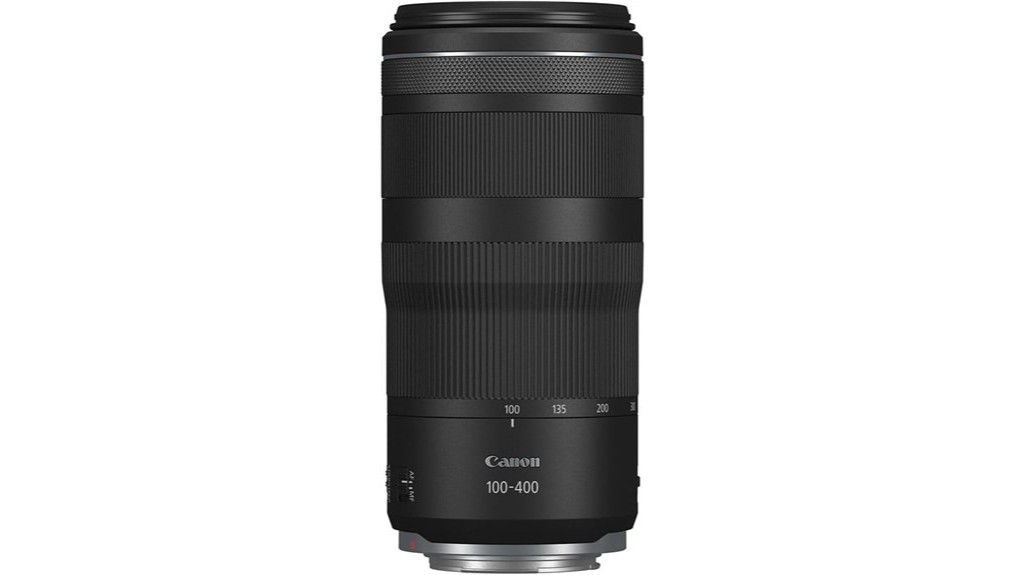
The Canon RF100-400mm F5.6-8 IS USM stands out as an excellent choice for photographers seeking a lightweight telephoto solution without sacrificing reach. At just 1.8 pounds, it’s surprisingly compact yet delivers impressive versatility for wildlife photography.
You’ll appreciate the powerful image stabilization system, offering up to 5.5 stops of correction (6 stops with compatible R-series bodies). The Nano USM autofocus delivers quick, quiet performance that’s essential for capturing elusive wildlife.
While it’s not the brightest lens with its f/5.6-8 aperture range, the sharpness and 0.41x maximum magnification compensate nicely. For extended reach, add teleconverters to achieve effective focal lengths up to 800mm.
Best For: Amateur and enthusiast photographers using Canon’s EOS R-series cameras who need a lightweight telephoto zoom for wildlife, sports, and travel photography without breaking the bank.
Pros:
- Exceptionally lightweight (1.8 pounds) and compact design makes it easy to carry for extended photo sessions
- Impressive image stabilization system provides up to 6 stops of correction when paired with IBIS-equipped Canon bodies
- Compatible with RF teleconverters, extending reach up to 800mm for distant wildlife subjects
Cons:
- Relatively narrow maximum aperture range (f/5.6-8) limits performance in low light situations
- Lacks weather sealing for protection against dust and moisture
- Some users report the zoom ring operates in the opposite direction compared to other Canon lenses
High-Power 420-1600mm Manual Telephoto Zoom Lens for Canon Cameras
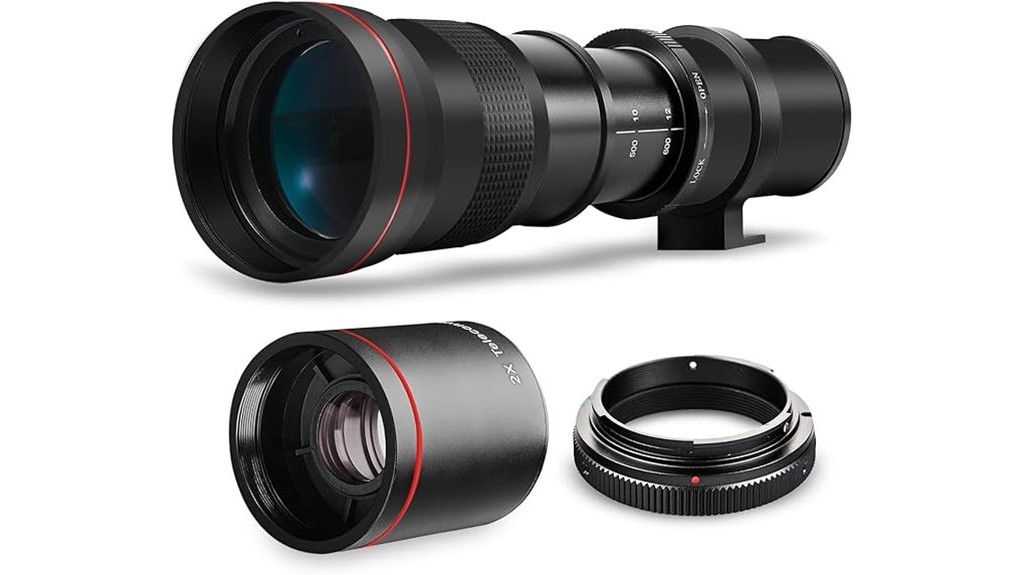
Photographers seeking extreme telephoto reach on a budget will find Canon’s High-Power 420-1600mm Manual Telephoto Zoom Lens appealing for wildlife photography. With its impressive 420-1600mm range (using the included 2X teleconverter), you’ll capture distant subjects that remain beyond reach with standard telephoto lenses.
Be prepared for manual operation—this lens requires thoughtful setup with a sturdy tripod and remote shutter release. Despite its f/8.3 aperture that drops to f/16 at 800mm, many users report surprisingly good image quality given the price point. Remember, you’re trading autofocus and image stabilization for extraordinary reach at a fraction of professional lens costs.
Best For: Budget-conscious photographers who need extreme telephoto reach for wildlife and astronomical photography and are willing to work with manual focus and tripod setups.
Pros:
- Impressive focal length range of 420-1600mm with included 2X teleconverter
- Affordable price point compared to professional telephoto lenses with similar reach
- Compatible with a wide range of Canon DSLR cameras including T-series and EOS models
Cons:
- Lacks autofocus and image stabilization, requiring manual operation
- Narrow aperture (f/8.3-f/16) limits use in low light conditions
- Requires a sturdy tripod and remote shutter release for optimal results due to high magnification
Canon RF100-500mm F4.5-7.1 L is USM Super-Telephoto Zoom Lens

Serious wildlife enthusiasts seeking exceptional reach without compromising mobility will find the Canon RF100-500mm F4.5-7.1 L IS USM a game-changing addition to their kit. This lightweight 3-pound marvel delivers impressive versatility with its 100-500mm range.
You’ll appreciate the lightning-fast Dual Nano USM motors that track moving subjects silently and precisely. The 5-stop image stabilization system keeps your shots sharp even when handholding at 500mm.
The weather-sealed L-series construction means you can confidently shoot in challenging conditions. While its variable aperture requires ISO adjustments in dim light, the exceptional image quality from its specialized UD elements makes this a worthy investment.
Best For: Wildlife and sports photographers who need exceptional reach and portability in a weather-sealed package compatible with Canon’s mirrorless R-series cameras.
Pros:
- Impressive 100-500mm focal range with excellent image quality thanks to specialized UD elements
- Lightweight design (3 pounds) with effective 5-stop image stabilization makes handheld shooting feasible
- Fast, silent Dual Nano USM motors deliver precise autofocus tracking for moving subjects
Cons:
- Variable aperture (F4.5-7.1) requires ISO adjustments in low light conditions
- Price point represents a significant investment for amateur photographers
- Limited to Canon RF mount, requiring an adapter for use with older Canon DSLR lenses
JINTU 420-1600mm f/8.3 Telephoto Zoom Lens for Canon SLR Cameras
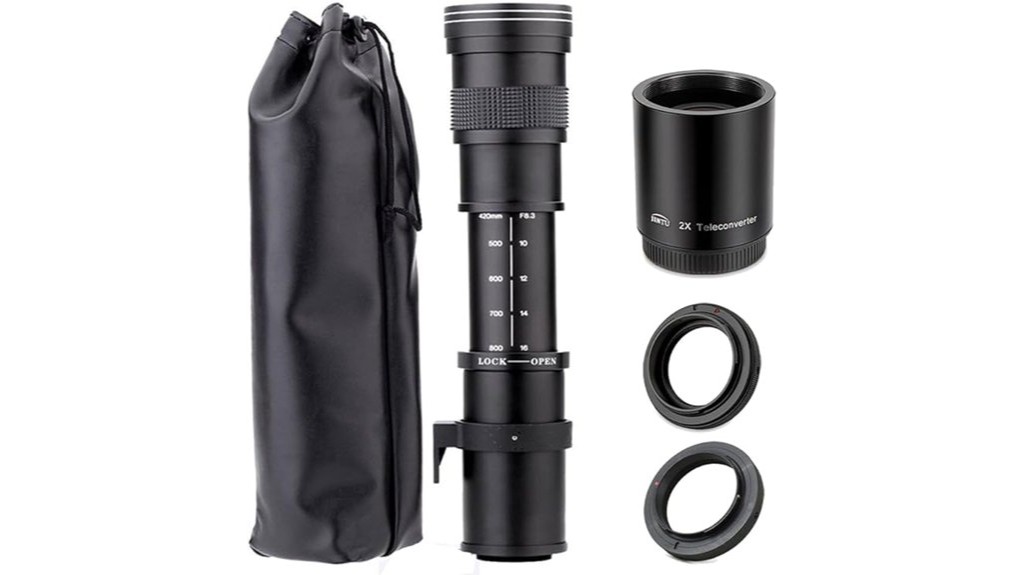
For wildlife enthusiasts seeking extremely long focal lengths without breaking the bank, JINTU’s 420-1600mm f/8.3 telephoto zoom offers remarkable reach at a fraction of premium lens prices.
This manual focus lens features a durable all-metal construction with multi-coated glass for crisp images. You’ll need to master manual settings as the aperture is fixed at f/8.3. Compatible with various Canon EOS models, it can also work with other brands using adapters.
At higher zoom levels, you’ll need steady positioning to maintain focus. Despite its challenges, customers rate it 4.2/5 stars, praising its value for wildlife photography.
Best For: Budget-conscious wildlife and nature photographers who are willing to learn manual focusing techniques and want extreme zoom capabilities without investing in premium telephoto lenses.
Pros:
- Exceptional zoom range (420-1600mm with teleconverter) at an affordable price point
- Durable all-metal construction with multi-coated glass for quality images
- Compatible with various Canon EOS models and adaptable to other camera brands
Cons:
- Fixed f/8.3 aperture limits shooting in low-light conditions
- Completely manual focus requires practice and patience to master
- Requires steady positioning at higher zoom levels to maintain focus on subjects
JINTU Telephoto Zoom Lens 420-1600mm F/8.3 for Canon EF

Wildlife enthusiasts seeking an affordable entry into super-telephoto photography will find the JINTU Telephoto Zoom Lens 420-1600mm F/8.3 a compelling option. It offers impressive reach from 420-800mm, extending to 1600mm with the included 2X teleconverter.
This manual focus lens performs well in bright conditions for capturing distant subjects like birds and the moon. You’ll need a sturdy tripod – this isn’t negotiable, as the 2.5lb aluminum alloy construction requires stability for sharp images.
While it can’t match Canon’s professional lenses costing thousands more, it’s a practical starting point if you’re exploring wildlife photography without breaking the bank.
Best For: Budget-conscious wildlife and nature photographers looking to capture distant subjects without investing thousands in professional telephoto lenses.
Pros:
- Impressive reach with focal lengths from 420-800mm, extendable to 1600mm with the included teleconverter
- Affordable entry point into super-telephoto photography compared to high-end alternatives
- Performs well for moon photography and wildlife shooting in bright lighting conditions
Cons:
- Manual focus only with no auto-focus capability, requiring more skill and patience
- Requires a sturdy, quality tripod for sharp images due to the lens’s weight and length
- Image quality deteriorates in low light conditions and may not match the sharpness of more expensive options
JINTU 420-800mm f/8.3 Manual Telephoto Lens for Canon EF Mount
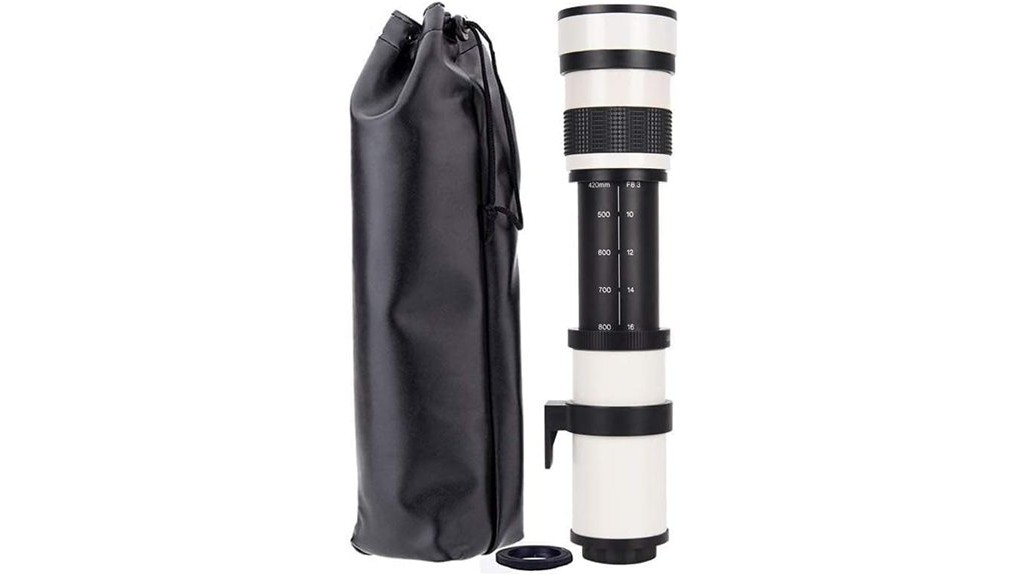
Budget-conscious photographers seeking impressive reach without breaking the bank will find the JINTU 420-800mm f/8.3 Manual Telephoto Lens an attractive option. At under $100, this Canon EF-compatible lens delivers substantial zoom for wildlife photography.
The 420-800mm range lets you capture distant subjects with its all-metal construction and multi-coated glass. While you’ll need to master manual focusing and use a tripod for stability, many users report satisfying results for nature and moon photography.
Don’t expect professional-grade sharpness or convenience—there’s no autofocus and your camera may not detect the lens—but for occasional wildlife shooting, it offers remarkable value.
Best For: Budget-conscious hobbyist photographers seeking extreme zoom reach for wildlife, sports, or lunar photography who are willing to work with manual controls and have a stable tripod.
Pros:
- Impressive 420-800mm zoom range at a remarkably low price point (under $100)
- Durable metal construction with multi-coated glass for decent image quality considering the cost
- Lightweight and portable design (1.76 lbs) makes it suitable for travel and outdoor photography
Cons:
- Completely manual operation with no autofocus capability requires practice and patience
- Camera may not detect the lens, requiring full manual shooting mode
- Image quality, while acceptable for the price, doesn’t compare to professional telephoto lenses
Canon 70-300mm f/4-5.6 Zoom Camera Lens

The Canon 70-300mm f/4-5.6 IS II USM lens stands as a versatile workhorse for photographers seeking to capture wildlife without breaking the bank. Its Advanced NANO USM technology delivers quick autofocus performance essential for unpredictable wildlife moments.
You’ll appreciate the four-stop image stabilization when shooting handheld, allowing surprisingly sharp images at slow shutter speeds—even 1/25th second at 300mm. With a minimum focusing distance under four feet, you can capture detailed nature shots.
While it lacks the premium build of L-series glass, the 4.6-star rating confirms its excellent value. For budget-conscious wildlife photographers, this lightweight 1.56-pound lens delivers impressive results.
Best For: Amateur and enthusiast photographers looking for an affordable telephoto zoom lens that delivers sharp images for wildlife, sports, and portrait photography without the weight or cost of professional L-series glass.
Pros:
- Excellent image stabilization system compensates for up to four stops of camera shake, allowing for sharp handheld images even at 300mm and slower shutter speeds
- Fast and quiet Advanced NANO USM autofocus technology performs well for both still photography and video recording
- Lightweight design at 1.56 pounds makes it comfortable for all-day shooting and travel photography
Cons:
- Not weather-sealed like Canon’s more expensive L-series lenses, requiring extra care in adverse conditions
- Variable maximum aperture (f/4-5.6) limits low-light performance, especially when zoomed to 300mm
- LCD information display receives mixed reviews from users who prefer traditional printed markings for focus distance and focal length
Sony FE 200-600mm F5.6-6.3 G OSS Super Telephoto Zoom Lens (SEL200600G)
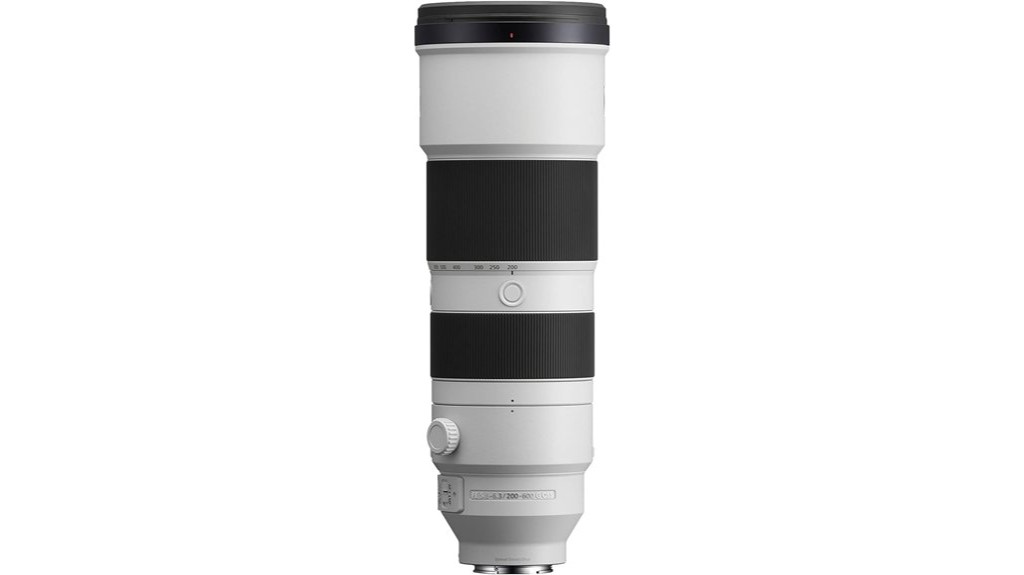
For photographers seeking exceptional reach without breaking the bank, Sony’s FE 200-600mm F5.6-6.3 G OSS stands as a compelling option in the super telephoto landscape. This 4.66-pound lens delivers impressive sharpness across its entire zoom range thanks to five ED glass elements and Nano AR coating.
You’ll appreciate the fast, quiet autofocus driven by Sony’s Supersonic Wave Motor, while the internal zoom mechanism maintains consistent balance during use. The 90° zoom throw lets you quickly shift between focal lengths.
Though heavier than some alternatives, wildlife photographers consistently praise its image quality and value, making it particularly ideal for bird photography.
Best For: Wildlife and bird photographers seeking exceptional reach with sharp image quality who don’t mind the weight for the value and performance this super telephoto zoom lens provides.
Pros:
- Exceptional sharpness throughout the 200-600mm zoom range with five ED glass elements and Nano AR coating to minimize flare and ghosting
- Fast, quiet, and precise autofocus with Direct Drive Supersonic Wave Motor and customizable function buttons
- Internal zoom mechanism provides consistent weight balance with a quick 90° zoom throw for rapid focal length transitions
Cons:
- Relatively heavy build at 4.66 pounds makes extended handheld shooting challenging and often requires tripod/gimbal support
- Some users report busy background blur (bokeh) and occasional issues with background separation
- Hood locking mechanism has been noted as an area for potential improvement by some users
High-Power 500mm/1000mm Manual Telephoto Lens for Canon EOS Cameras

Wildlife photographers seeking extreme magnification without breaking the bank will find the High-Power 500mm/1000mm manual telephoto lens an intriguing option. This Canon-compatible lens delivers impressive reach at 500mm, extendable to 1000mm with the included teleconverter.
You’ll appreciate the multi-coated glass that enhances image quality, though you’ll need a sturdy tripod to combat the lack of image stabilization. At just 1.5 pounds, it’s surprisingly lightweight for its capabilities.
While it lacks autofocus and requires manual adjustments, many users report satisfying sharpness compared to pricier alternatives. It’s an economical entry point for wildlife photography, though performance varies based on your experience with manual lenses.
Best For: Amateur wildlife and astronomy photographers seeking extreme magnification capabilities at an affordable price point who have experience with manual focusing or are willing to learn.
Pros:
- Impressive 500mm/1000mm focal length allows for extreme telephoto reach at a fraction of the cost of professional lenses
- Lightweight design (1.5 pounds) makes it more portable than most telephoto lenses with similar magnification
- Multi-coated optical glass delivers surprisingly good image quality for the price point
Cons:
- Completely manual focus system requires practice and patience, especially at maximum magnification
- Lacks image stabilization, making a sturdy tripod essential for sharp images
- Some users report mechanical issues with attachment points loosening during use
Long-Range Telephoto Zoom Lens for Nikon DSLR Cameras
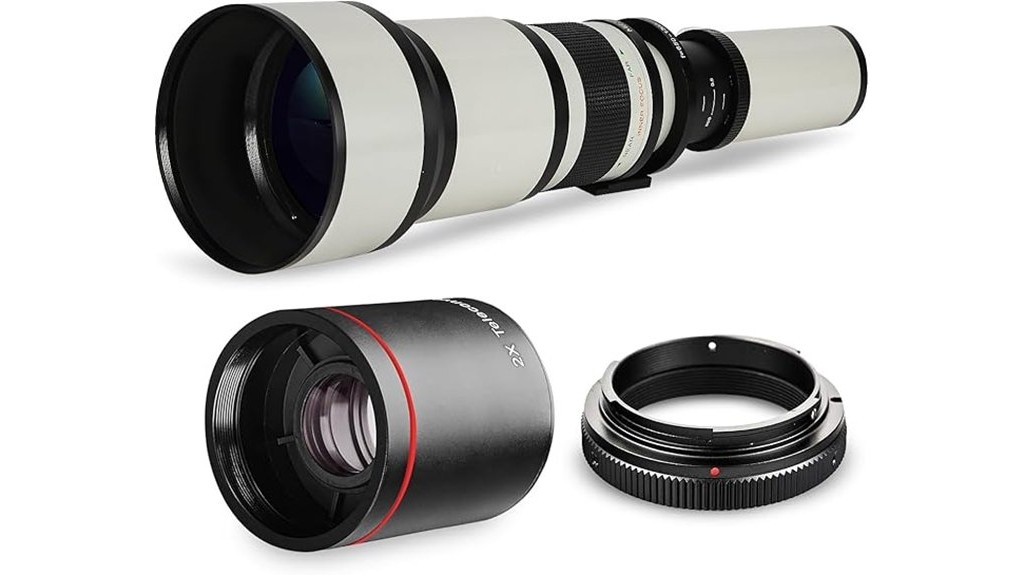
Long-range telephoto zoom lenses empower Nikon DSLR photographers to capture distant wildlife subjects with remarkable detail. This 650-1300mm f/8 lens extends to an impressive 2600mm with the included 2X teleconverter, perfect for skittish animals.
Compatible with numerous Nikon models from the D3000 series to the D850, it features multi-coated optics for enhanced image clarity. The F-Mount guarantees secure attachment for best results.
You’ll need a tripod for stability, as customers note the stiff zoom mechanism and focusing challenges at extreme lengths. With a minimum focusing distance of 16 feet, you’ll achieve better results with distant subjects rather than close-up wildlife.
Best For: Wildlife and astronomy photographers using Nikon DSLRs who need extreme focal lengths for capturing distant subjects and are willing to work with manual focus challenges.
Pros:
- Impressive focal range from 650mm to 2600mm with included teleconverter enables capturing extremely distant subjects
- Compatible with numerous Nikon DSLR camera models from entry-level D3000 series to professional D850
- Multi-coated optical glass enhances image sharpness and clarity when properly stabilized
Cons:
- Requires a sturdy tripod for stability due to its weight (5.24 pounds) and extreme focal length
- Stiff zoom mechanism and challenging manual focus, especially at longer focal lengths
- Minimum focusing distance of 16 feet limits versatility for closer wildlife photography
36X Long Focus Telephoto Phone Lens for iPhone and Android
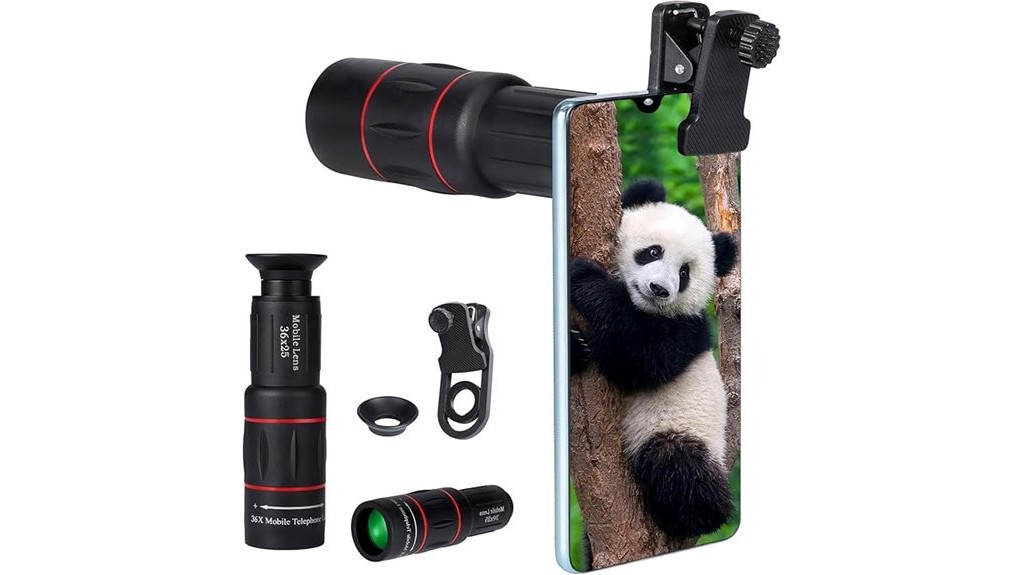
Smartphone photographers seeking professional-quality wildlife shots without investing in bulky DSLR equipment will find the 36X Long Focus Telephoto Phone Lens a game-changing addition to their kit.
At just 7 ounces, this compact lens eliminates the pixelation typically seen with digital zoom while delivering impressive clarity for wildlife photography. You’ll appreciate its anti-shake design and high-quality FMC glass when capturing distant subjects.
Compatible with most major smartphones including iPhone 12-16 and Samsung Galaxy S series, it’s backed by a 60-day money-back guarantee. The dual-purpose design also functions as a mini monocular telescope—perfect for scouting wildlife before taking the perfect shot.
Best For: Wildlife photographers, concert-goers, and sports enthusiasts who want professional-quality zoom capabilities without carrying bulky DSLR equipment.
Pros:
- Provides 36X optical zoom that eliminates the pixelation common with digital zoom while maintaining image clarity
- Lightweight (7 ounces) and compact design (4.9 x 1.5 x 1.5 inches) makes it highly portable for outdoor adventures
- Dual functionality as both a phone lens and mini monocular telescope adds versatility for wildlife spotting
Cons:
- May require practice to master stabilization techniques despite the anti-shake design
- Setup process might be challenging for some users as indicated by customer feedback
- Results can vary depending on user technique and environmental conditions
APEXEL 36X HD Telephoto Lens for Smartphones with Tripod
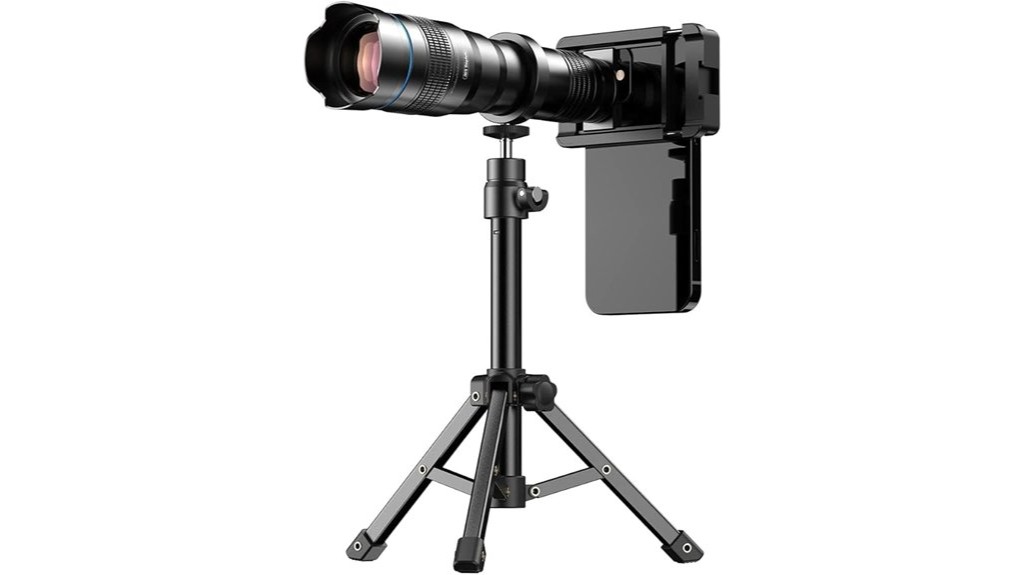
For mobile photography enthusiasts seeking powerful zoom capabilities without carrying bulky equipment, the APEXEL 36X HD Telephoto Lens transforms your smartphone into a wildlife photography tool.
This versatile lens captures images up to 8000 meters away with impressive clarity, making it perfect for bird watching and wildlife observation. Constructed from optical glass and aircraft-grade aluminum, it minimizes distortion while providing crisp focus.
You’ll appreciate its compatibility with virtually all smartphones including iPhone and Samsung models. The adjustable focus eliminates dark areas common in lesser telephoto attachments.
Whether you’re tracking animals on safari or photographing birds in your backyard, this compact lens delivers professional-quality results.
Best For: Nature enthusiasts, sports fans, and travelers who want professional-quality zoom photography without carrying bulky camera equipment.
Pros:
- Impressive 36X zoom capability allows clear photography of subjects up to 8000 meters away
- Universal compatibility with most smartphone models including iPhone, Samsung, and Google Pixel
- High-quality construction using optical glass and aircraft-grade aluminum minimizes distortion
Cons:
- May require steady hands or the included tripod to avoid camera shake at maximum zoom
- Adjustable focus might have a learning curve for photography beginners
- While portable compared to professional telescopic lenses, it adds some bulk to your smartphone
420-800mm Telephoto Zoom Lens for Canon EOS DSLR Cameras
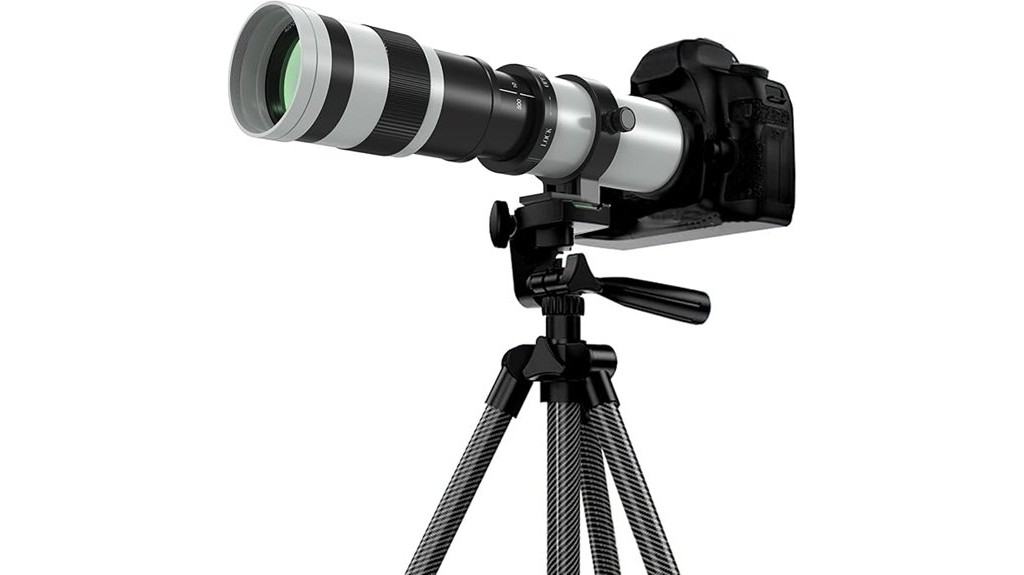
Wildlife photographers seeking maximum reach without breaking the bank will find the 420-800mm telephoto zoom an attractive option for Canon DSLR cameras. This manual focus lens offers impressive focal range at a budget-friendly price point.
With a fixed aperture of F/8.3-16, you’ll need to shoot in Manual mode as the camera won’t detect aperture settings. While it lacks autofocus capabilities, users report excellent results for moon photography and distant wildlife subjects when properly supported on a tripod.
Compatible with most Canon DSLRs but not mirrorless models, this 1.7-pound lens represents good value for hobbyists exploring super-telephoto photography.
Best For: Budget-conscious wildlife and astronomy photographers using Canon DSLRs who are willing to master manual focus techniques and want extreme telephoto reach.
Pros:
- Impressive 420-800mm focal range at a fraction of the cost of professional super-telephoto lenses
- Compatible with a wide range of Canon DSLR cameras from entry-level to professional
- Lightweight design (1.7 pounds) compared to other super-telephoto options
Cons:
- Manual focus only with no electronic communication with the camera
- Fixed aperture range (F/8.3-16) requires good lighting conditions for optimal results
- Image quality issues like chromatic aberration may appear, especially at maximum zoom
APEXEL 36X Telephoto Lens Kit for Smartphone

When capturing distant wildlife without disturbing their natural behavior, the APEXEL 36X Telephoto Lens Kit transforms your smartphone into a powerful photography tool. You’ll appreciate how it brings subjects up to 8000 meters closer without sacrificing image quality.
The 4K HD lens delivers clear images without dark corners or distortion, thanks to quality optical glass and aircraft-grade aluminum construction. It’s compatible with most smartphones including iPhones, Samsung Galaxy, and Google Pixel devices.
Perfect for bird watching, hiking, and nature exploration, this portable lens doubles as a monocular. The included tripod provides necessary stabilization for crisp shots. At just 1.68 pounds, you’ll hardly notice it in your pack.
Best For: Nature enthusiasts, wildlife photographers, and travelers seeking to capture distant subjects without disturbing them or compromising image quality.
Pros:
- Impressive 36X magnification brings objects up to 8000 meters closer with focus adjustment capabilities
- Compatible with most popular smartphone models, including iPhone, Samsung Galaxy, and Google Pixel devices
- Versatile functionality as both a telephoto lens and monocular with included tripod for stability
Cons:
- Requires removal of phone case for proper attachment, which may be inconvenient
- At 1.68 pounds, it’s relatively heavy compared to other smartphone lens accessories
- Average customer rating of 3.4/5 suggests inconsistent user experiences or performance issues
Factors to Consider When Choosing Telephoto Lenses for Wildlife Photography
When selecting a telephoto lens for wildlife photography, you’ll need to weigh several critical factors that directly impact your shooting experience and results. Your choice should account for focal length range, aperture settings, image stabilization capabilities, the lens’s physical weight, and whether it offers weather sealing protection. These considerations will determine not only the quality of your wildlife images but also how comfortably you can work in various field conditions.
Focal Length Range
Selecting the right focal length range stands as perhaps the most critical decision when choosing a telephoto lens for wildlife photography. For most wildlife scenarios, you’ll want to aim for 300-500mm, which provides excellent detail while maintaining a respectful distance from your subjects.
If you’re seeking dramatic, tightly framed compositions, consider lenses offering 600mm or beyond for extreme magnification. However, versatility often trumps maximum reach—zoom lenses in the 100-400mm or 200-600mm range let you adapt quickly to changing situations without switching equipment.
Don’t overlook minimum focusing distance; lenses that can focus within 3-5 feet allow for impressive close-ups of smaller creatures. Remember that longer focal lengths typically come with smaller maximum apertures, potentially limiting your options in dim lighting conditions.
Aperture and Light Sensitivity
Despite its often overlooked importance, aperture stands as the critical factor determining how much light your telephoto lens captures in wildlife photography. Selecting a lens with a wider maximum aperture (f/4 versus f/5.6) dramatically improves your shooting flexibility in the dim lighting conditions wildlife photographers frequently encounter.
The wider aperture allows faster shutter speeds essential for freezing motion when photographing active animals, preventing the frustration of motion blur. You’ll also benefit from better subject isolation, as the shallower depth of field helps your wildlife subject stand out against potentially distracting backgrounds.
While lenses typically perform sharpest when stopped down about two stops from maximum aperture, you’ll need to balance this consideration against maintaining sufficient light for proper exposure, especially during dawn and dusk wildlife activity.
Image Stabilization Capabilities
Image stabilization technology represents one of the most essential features to reflect upon in wildlife telephoto lenses. When you’re tracking animals in their natural habitats, IS systems can compensate for up to 5 stops of camera shake, delivering sharper images without requiring a tripod.
This feature becomes particularly valuable when using longer focal lengths, where even slight movements can result in blurry photos. Different manufacturers offer specialized stabilization modes designed specifically for tracking moving wildlife, giving you added versatility in the field.
Without IS, you’d need to rely on faster shutter speeds or carry bulky tripods, limiting your spontaneity and mobility. When choosing your wildlife lens, prioritize models with built-in stabilization to maintain clarity and detail even in challenging shooting conditions and dynamic wildlife encounters.
Weight and Portability
The burden of a hefty telephoto lens can quickly transform an exciting wildlife expedition into an exhausting ordeal. When selecting your wildlife lens, prioritize models under 2.5 pounds to reduce fatigue during long treks through natural habitats. Lightweight options starting around 1.5 pounds offer markedly improved handling compared to professional lenses exceeding 4 pounds.
Consider dimensions carefully—lenses longer than 12 inches often require tripods for stability, limiting your mobility in the field. Look for compact designs that leverage advanced materials to balance zoom capabilities with manageable weight. A removable tripod collar is also invaluable, providing necessary support for larger lenses while maintaining flexibility for different shooting angles. These weight considerations will guarantee you’re not missing perfect wildlife moments because you’re too exhausted to reach for your camera.
Weather Sealing Protection
When venturing into wildlife habitats, your expensive telephoto lens needs robust protection against the elements. Weather sealing is non-negotiable for serious wildlife photography, as it shields your gear from moisture, dust, and temperature fluctuations that could compromise performance at pivotal moments.
Look for lenses featuring thorough sealing systems with gaskets and protected openings that prevent water and dust infiltration. Many premium telephoto options include fluorine-coated front elements that repel water, oil, and dirt, maintaining optical clarity and simplifying field maintenance.
Don’t overlook the level of weather protection when comparing models. Lenses designed specifically for outdoor use undergo rigorous testing to guarantee durability. With a properly sealed telephoto lens, you’ll capture those fleeting wildlife moments confidently, regardless of rain, mist, or dusty conditions.
Autofocus Speed Performance
Even as your lens stands protected against the elements, wildlife photography demands lightning-fast response times. When tracking unpredictable subjects, your lens’s autofocus capabilities become essential to capturing that perfect moment.
Look for lenses equipped with advanced technologies like USM or Nano USM motors, which deliver swift, quiet focusing that won’t startle skittish animals. Lenses with wider maximum apertures offer superior low-light autofocus performance—particularly valuable during dawn and dusk when wildlife is most active.
Be aware that even premium telephoto lenses may struggle in challenging conditions like dense foliage or dappled light. You’ll occasionally need to switch to manual focus for difficult scenarios. Remember, autofocus precision directly impacts image sharpness, especially when photographing erratically moving subjects like birds in flight.
Telephoto lenses for wildlife photography
You’ve now seen the top telephoto lenses for wildlife photography. Whether you’re choosing Canon’s professional RF100-500mm or a budget-friendly option like the 75-300mm, remember to prioritize your specific needs. Consider focal length, aperture, weight, and weather sealing before making your decision. With the right lens in your kit, you’ll be capturing those breathtaking wildlife moments in no time.

Erzsebet Frey (Eli Frey) is an ecologist and online entrepreneur with a Master of Science in Ecology from the University of Belgrade. Originally from Serbia, she has lived in Sri Lanka since 2017. Eli has worked internationally in countries like Oman, Brazil, Germany, and Sri Lanka. In 2018, she expanded into SEO and blogging, completing courses from UC Davis and Edinburgh. Eli has founded multiple websites focused on biology, ecology, environmental science, sustainable and simple living, and outdoor activities. She enjoys creating nature and simple living videos on YouTube and participates in speleology, diving, and hiking.
🌿 Explore the Wild Side!
Discover eBooks, guides, templates and stylish wildlife-themed T-shirts, notebooks, scrunchies, bandanas, and tote bags. Perfect for nature lovers and wildlife enthusiasts!
Visit My Shop →
